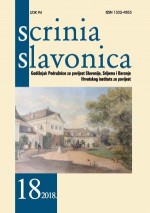Likovna i rukopisna ostavština Ladislava grofa Pejačevića iz Retfale i Rume
The Legacy of Art Works and Manuscripts of Count Ladislav Pejačević from Retfala and Ruma
Author(s): Đorđe Bošković, Jasminka Najcer SabljakSubject(s): Visual Arts, Local History / Microhistory, Recent History (1900 till today), 19th Century
Published by: Hrvatski institut za povijest
Keywords: count Ladislav Pejačević; Retfala; Ruma; Eltz family; memoirs; Revolution of 1848; visual arts;
Summary/Abstract: The text of the memoirs of Count Ladislav Pejačević (1828-1916) was found at Herrnau Castle (a southern suburb of Salzburg), the residence of his heirs, the Clary-Aldringen family. The legacy of the Ruma-Retfala family Pejačević was preserved in this castle; the grand seat of the family was at Retfala Castle in the western part of Osijek and the business headquarters were in Ruma (today the Republic of Serbia). This text was revised and typewritten in 1975 by its author’s grandson Count Hinko Khuen Bélasi. Of major importance in the events described is a significant event of the Eltz and Pejačević family history, i.e. the tragic fate of Count Hugo Eltz, the husband of Ladislav’s sister Ludvina, who was killed in Vukovar on October 26, 1848. The author of Uspomene described, among events referring to the family, the social and political circumstances that had led to this homicide, hence the text offers a very interesting view of the history of the time in the territory of Slavonia and Syrmia. The text provides information on political figures and events as well as on the daily life of noble families in the mid-19th century and it adds to our previous knowledge on the topic. This paper provides a cultural-historical review of the text Uspomene and the Croatian translation. Along with biographical data on the author, the paper also provides a review of the legacy of the Ruma-Retfala branch of the family and their Retfala manor with the prestigious neo-Classicist castle with its extensive grounds, which was in the mid-19th century at the peak of its social and cultural existence. The paper also discusses the role of Count Ladislav Pejačević in the history of the management of the Ruma estate, the economy of which he improved and stabilized. Special emphasis has been placed on the relation between Count Ladislav Pejačević and the fine arts. Some of his drawings and watercolours with portraits of family members, notable persons from social life, the interior of the Vukovar Castle and of Vukovar were found. It is almost unknown to the public that he was an amateur painter and that his family established a productive relationship with the Austrian painter Franz Alt, whose oeuvre includes paintings and depictions painted at the Slavonian and Syrmian estates of the Pejačević and Eltz families, and who most likely had an influence on Ladislav’s art of painting and the quality of his works.
Journal: Scrinia Slavonica
- Issue Year: 2018
- Issue No: 18
- Page Range: 129-174
- Page Count: 46
- Language: Croatian

